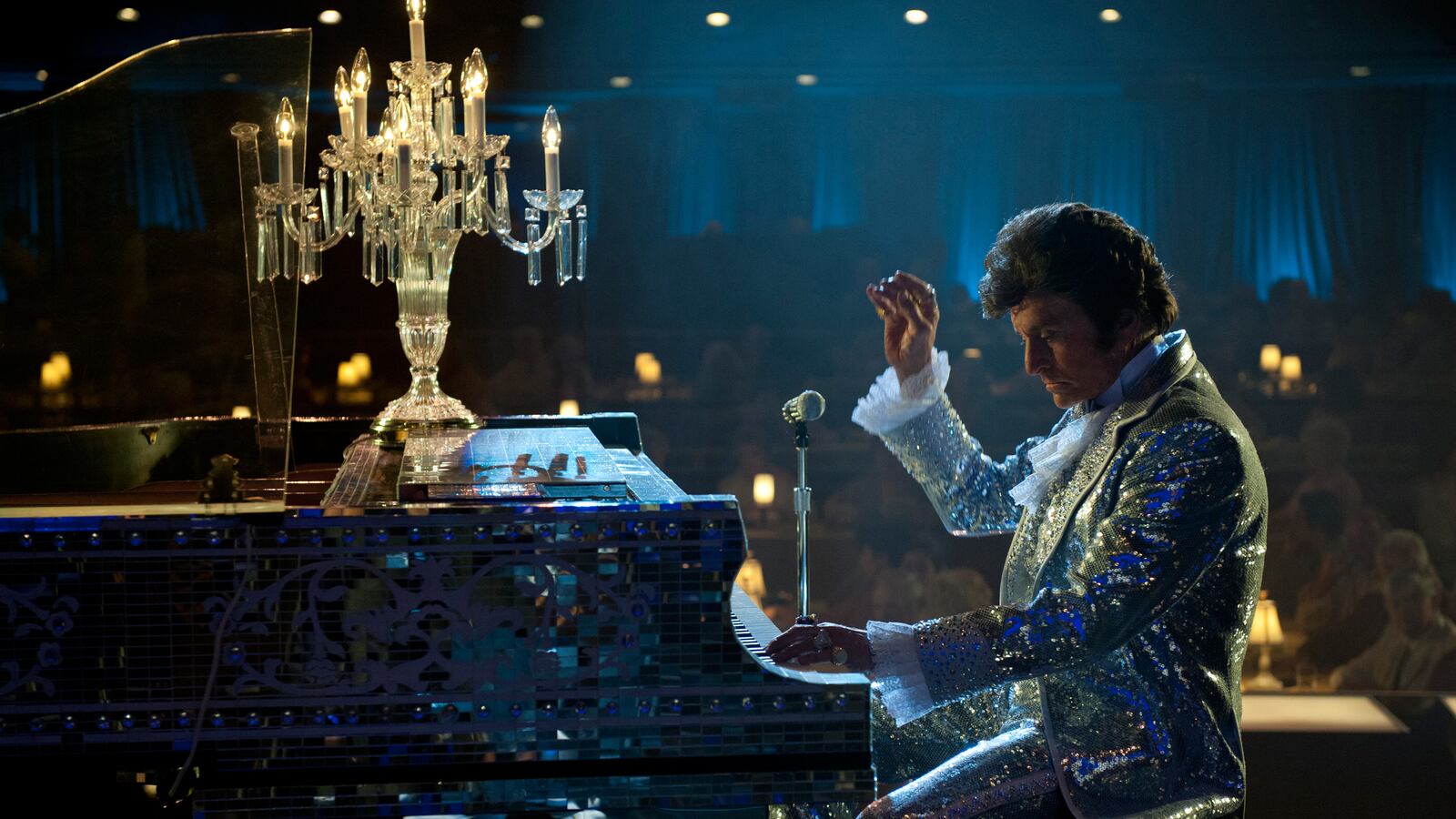If you Google Liberace, the word “flamboyant” turns up repeatedly. A double-edged epithet, “flamboyant” has long been a common euphemism for a campy gay sensibility and also aptly defines the career of a crowd-pleasing pianist who, almost despite himself, ended up having an enormous influence on American popular culture. Sporting an impeccably coiffed pompadour (simulated, in later years, by well-positioned wigs) Liberace performed in gold lamé suits and sequins for largely conservative, heterosexual audiences. During the 1950s, his television program introduced millions of viewers to classical music through virtuosic, if gimmicky, interpretations of Chopin and Liszt.

Steven Soderbergh’s Behind the Candelabra, which premiered Tuesday at Cannes, stars, however incongruously, Michael Douglas as Elvis and Elton John’s self-mocking predecessor. The film, which will be broadcast on HBO on May 26, is less concerned with chronicling Liberace’s musical and cultural legacy than zeroing in on the most notorious years of his career—his tumultuous relationship with the much younger Scott Thorson (Matt Damon), an earnest young hunk and animal trainer who triumphs over a stable of rivals to become the illustrious man’s occasional chauffeur and full-time lover. Despite a tonal shift that converts Candelabra’s initially farcical ambiance into darker melodramatic terrain—imagine an eccentric amalgam of Who’s Afraid of Virginia Woolf? and Scenes from a Marriage— Soderbergh’s film rings changes on a Hollywood staple: musical biopics like Walk the Line that chart an iconic star’s road from addiction to eventual redemption.
Soderbergh skips the redemption chapter of this template since Liberace, a closeted gay man who remained impervious to post-Stonewall developments, ends up as a tragic, contradictory figure. At the time of his death from AIDS in 1987, the New York Times’s obituary reported that he had passed away from “cardiac arrest due to congestive heart failure brought on by subacute encephalopathy.”
Even though this might sound like heart-wrenching material, it’s important to note that much of the film is extremely funny. After being repelled by his own aging visage on The Tonight Show, Liberace compares himself to Judy Garland during her “obese, Sid Luft ” period. Paying a backhanded compliment to Jane Fonda, he salutes the actress for starring in On Golden Pond and downplaying her vulgar penchant for activism. “It’s not our business to change the world,” proclaims one of Las Vegas’s greatest showmen. “It’s our business to entertain the world.” When Liberace’s elderly mother Frances (Debbie Reynolds) wins the jackpot while playing her son’s home slot machine, she remarks that he can send her a check since there’s no ready cash on hand.
For Liberace, entertaining the world entailed transforming the way he looked; some of the most disturbing sequences in Behind the Candelabra are devoted to his intensive plastic surgery and bizarre insistence that Thorson undergo a procedure to transform himself into a younger version of his boss. Strung out on a punishing regimen of diet pills, the once genial young man becomes a sullen, self-pitying wreck. (Soderbergh intercuts one of Liberace’s Vegas performances with shots of Thorson being subjected to surgery that might as well be medieval torture.) In a peculiar turn of events, Liberace, the devout Catholic, accuses his boy toy of being a hopeless prude.

In other hands, this scenario might have degenerated into a caricature-filled freak show. The fact that it doesn’t is attributable to Soderbergh’s relatively restrained direction and Douglas's and Damon’s intelligently modulated performances. Douglas’s role obviously poses the bigger acting challenge. Because being over-the-top was such an integral aspect of Liberace’s persona (the film ends with his assertion that “too much of a good thing is wonderful”), Douglas is obliged to emulate the master entertainer’s sing-songy drawl and expansive gestures without seeming cartoonish. Damon, in a less showy role, subtly demonstrates his character’s progression from clueless naïf to hardened, drug-addicted cynic.
Of course, Liberace and Thorson became a notorious couple when the latter filed a palimony suit against his former lover. In contrast to early sequences’ light-hearted hijinks, Soderbergh and screenwriter Richard LaGravenese treat this crucial plot twist with well-earned sobriety. Scott’s attorney (Paul Reiser) negotiates a less-than-ideal settlement for his client; the implication seems to be that, just as in heterosexual relationships, the powerful and wealthy frequently lord over, if not swindle, their powerless partners.
At a juncture when Americans are increasingly embracing the concept of gay marriage, Behind the Candelabra occupies, a peculiar, if intriguing, niche. It’s neither a politically correct injunction to legalize the sort of union that Thorson and Liberace enjoyed informally nor a conservative anti-gay screed. In certain respects, it’s almost like a slightly lighter version of Rainer Werner Fassbinder’s Fox and His Friends (1975), a film in which a wily, middle-aged man shamelessly exploits his younger, more vulnerable lover.






